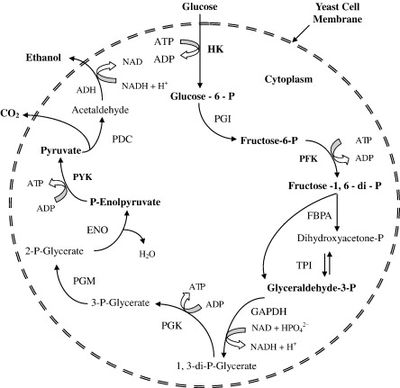Microbial Biofuels: Current Production and Future Prospects: Difference between revisions
No edit summary |
No edit summary |
||
| Line 1: | Line 1: | ||
==Introduction== | ==Introduction== | ||
<br>By [Student Name]<br> | <br>By [Student Name]<br> | ||
<br>At right is a sample image insertion. It works for any image uploaded anywhere to MicrobeWiki. The insertion code consists of: | <br>At right is a sample image insertion. It works for any image uploaded anywhere to MicrobeWiki. The insertion code consists of: | ||
| Line 21: | Line 21: | ||
==Current Microbial Biofuels: Ethanol Produced by Fermentation== | ==Current Microbial Biofuels: Ethanol Produced by Fermentation== | ||
<br><br> | <br> | ||
[[Image:Glycolysis_Overview.jpeg|thumb|400px|right|Figure 1. An overview of glycolysis. A single molecule of glucose is oxidized to two molecules of pyruvate. Pyruvate can then be decarboxylated to form acetaldehyde, which can act as the terminal electron receptor under anoxic conditions in S. cerevisiae to produce ethanol.<br><br> Image source: http://www.sciencedirect.com/science/article/pii/S0734975007001000 [3]]] | |||
<br> | |||
===Alternative Ethanol-Producing Microorganisms: Zymomonas mobilis and Escherichia coli=== | ===Alternative Ethanol-Producing Microorganisms: Zymomonas mobilis and Escherichia coli=== | ||
<br><br> | <br><br> | ||
Revision as of 01:07, 23 April 2013
Introduction
By [Student Name]
At right is a sample image insertion. It works for any image uploaded anywhere to MicrobeWiki. The insertion code consists of:
Double brackets: [[
Filename: PHIL_1181_lores.jpg
Thumbnail status: |thumb|
Pixel size: |300px|
Placement on page: |right|
Legend/credit: Electron micrograph of the Ebola Zaire virus. This was the first photo ever taken of the virus, on 10/13/1976. By Dr. F.A. Murphy, now at U.C. Davis, then at the CDC.
Closed double brackets: ]]
Other examples:
Bold
Italic
Subscript: H2O
Superscript: Fe3+
Introduce the topic of your paper. What microorganisms are of interest? Habitat? Applications for medicine and/or environment?
Current Microbial Biofuels: Ethanol Produced by Fermentation

Image source: http://www.sciencedirect.com/science/article/pii/S0734975007001000 [3]
Alternative Ethanol-Producing Microorganisms: Zymomonas mobilis and Escherichia coli
Alternative Feedstocks
Lignocellulose
Fatty Acids and Glycerol
Alternative Biofuels
Other Fermentation Products
Non-Fermentation Products
Improving Microbial Biofuel Production: Recent Developments
Using Efflux Pumps to Improve Biofuel Production
References
Edited by student of Joan Slonczewski for BIOL 238 Microbiology, 2011, Kenyon College.
